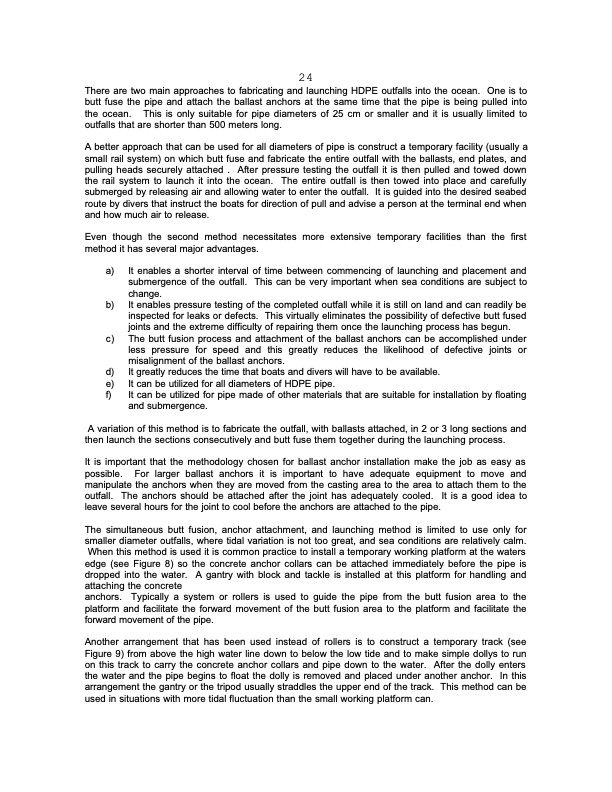
PDF Publication Title:
Text from PDF Page: 026
24 There are two main approaches to fabricating and launching HDPE outfalls into the ocean. One is to butt fuse the pipe and attach the ballast anchors at the same time that the pipe is being pulled into the ocean. This is only suitable for pipe diameters of 25 cm or smaller and it is usually limited to outfalls that are shorter than 500 meters long. A better approach that can be used for all diameters of pipe is construct a temporary facility (usually a small rail system) on which butt fuse and fabricate the entire outfall with the ballasts, end plates, and pulling heads securely attached . After pressure testing the outfall it is then pulled and towed down the rail system to launch it into the ocean. The entire outfall is then towed into place and carefully submerged by releasing air and allowing water to enter the outfall. It is guided into the desired seabed route by divers that instruct the boats for direction of pull and advise a person at the terminal end when and how much air to release. Even though the second method necessitates more extensive temporary facilities than the first method it has several major advantages. a) It enables a shorter interval of time between commencing of launching and placement and submergence of the outfall. This can be very important when sea conditions are subject to change. b) It enables pressure testing of the completed outfall while it is still on land and can readily be inspected for leaks or defects. This virtually eliminates the possibility of defective butt fused joints and the extreme difficulty of repairing them once the launching process has begun. c) The butt fusion process and attachment of the ballast anchors can be accomplished under less pressure for speed and this greatly reduces the likelihood of defective joints or misalignment of the ballast anchors. d) It greatly reduces the time that boats and divers will have to be available. e) It can be utilized for all diameters of HDPE pipe. f) It can be utilized for pipe made of other materials that are suitable for installation by floating and submergence. A variation of this method is to fabricate the outfall, with ballasts attached, in 2 or 3 long sections and then launch the sections consecutively and butt fuse them together during the launching process. It is important that the methodology chosen for ballast anchor installation make the job as easy as possible. For larger ballast anchors it is important to have adequate equipment to move and manipulate the anchors when they are moved from the casting area to the area to attach them to the outfall. The anchors should be attached after the joint has adequately cooled. It is a good idea to leave several hours for the joint to cool before the anchors are attached to the pipe. The simultaneous butt fusion, anchor attachment, and launching method is limited to use only for smaller diameter outfalls, where tidal variation is not too great, and sea conditions are relatively calm. When this method is used it is common practice to install a temporary working platform at the waters edge (see Figure 8) so the concrete anchor collars can be attached immediately before the pipe is dropped into the water. A gantry with block and tackle is installed at this platform for handling and attaching the concrete anchors. Typically a system or rollers is used to guide the pipe from the butt fusion area to the platform and facilitate the forward movement of the butt fusion area to the platform and facilitate the forward movement of the pipe. Another arrangement that has been used instead of rollers is to construct a temporary track (see Figure 9) from above the high water line down to below the low tide and to make simple dollys to run on this track to carry the concrete anchor collars and pipe down to the water. After the dolly enters the water and the pipe begins to float the dolly is removed and placed under another anchor. In this arrangement the gantry or the tripod usually straddles the upper end of the track. This method can be used in situations with more tidal fluctuation than the small working platform can.PDF Image | SMALL DIAMETER (HDPE) SUBMARINE OUTFALLS

PDF Search Title:
SMALL DIAMETER (HDPE) SUBMARINE OUTFALLSOriginal File Name Searched:
OPSCEPISPUB0060_eng.PDFDIY PDF Search: Google It | Yahoo | Bing
Development of a solar powered Electric Ship The Electricship website originally started off as a project to develop a comprehensive renewable, affordable, modular electric ship... More Info
Modular Boat Hull Composite The case for a unsinkable, modular composite hybrid boat hull... More Info
MS Burgenstock Hybrid Electric Catamaran Lake Lucerne Unique shuttle servicing Lucerne to the Burgenstock Resort... More Info
Ground Power Unit GPU Powered by Lithium Ion Batteries The goal of the Ground Power Unit is to provide a readily accessible, modular, ready-to-power solution for remote power... More Info
| CONTACT TEL: 608-238-6001 Email: greg@electricship.com | RSS | AMP |